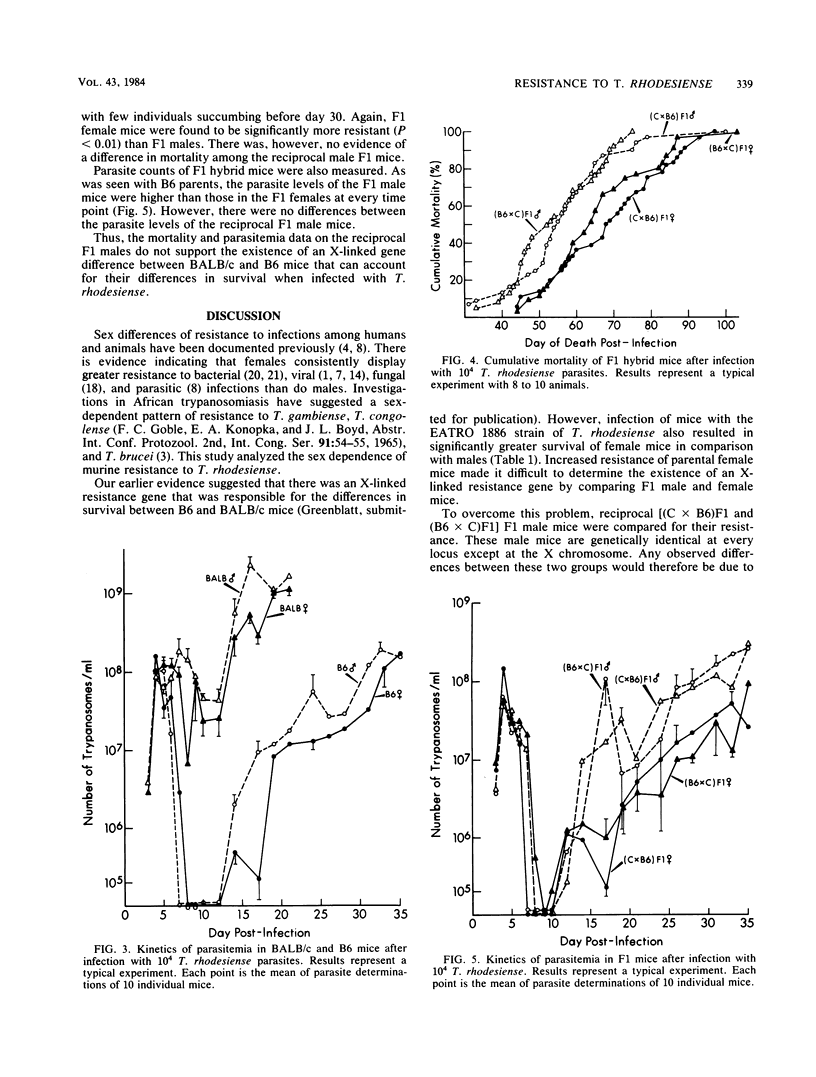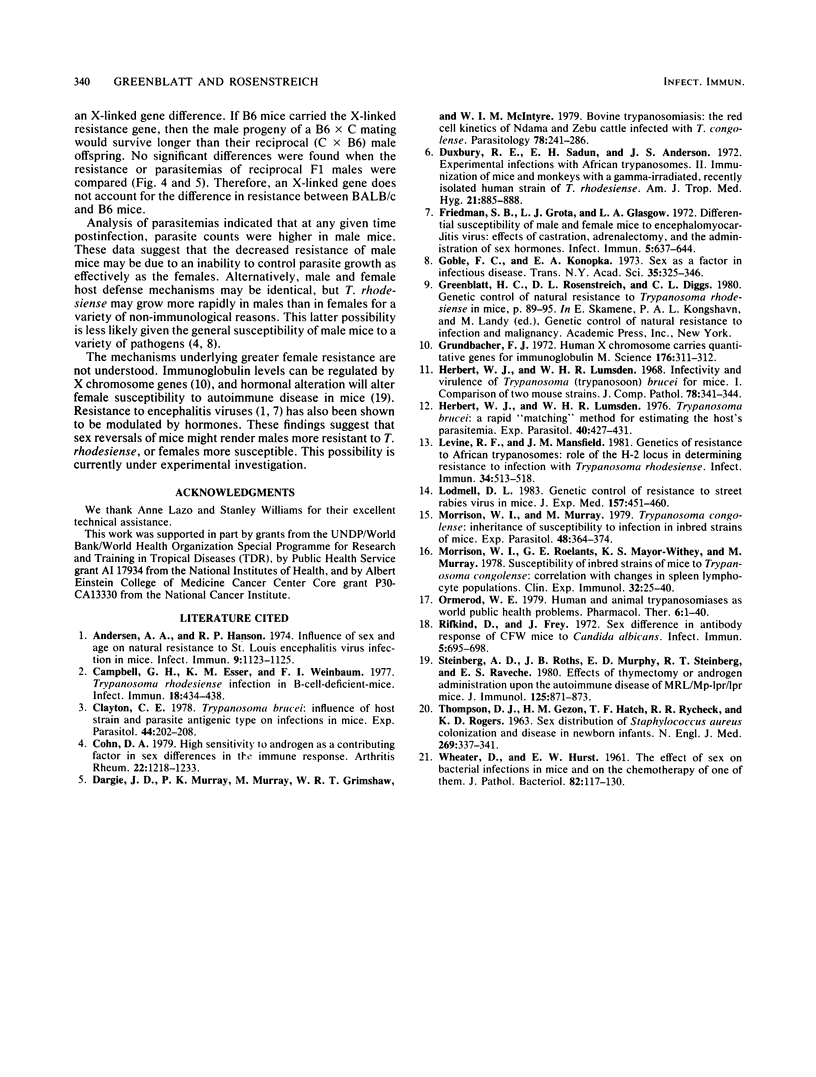Abstract
There is large variation in the survival of inbred mouse strains infected with Trypanosoma rhodesiense (EATRO 1886). Of those strains that survived for at least 22 days postinfection, female mice were markedly more resistant than male mice. The longer a strain survived, the greater was the difference in survival between male and female mice. Parasite counts were higher in male mice than in females, suggesting that the decreased resistance of males was due to their relative inability to control parasite growth. To determine the possible role of an X-linked resistance gene, resistant (C57BL/6) and susceptible (BALB/c) mice were mated, and their F1 progeny were infected with T. rhodesiense. There was no difference in the resistance between reciprocal F1 male mice (C57BL/6 X BALB/c versus BALB/c X C57BL/6), indicating that an X-linked gene does not account for the difference in resistance between susceptible and resistant mice.
Full text
PDF



Selected References
These references are in PubMed. This may not be the complete list of references from this article.
- Andersen A. A., Hanson R. P. Influence of sex and age on natural resistance to St. Louis encephalitis virus infection in mice. Infect Immun. 1974 Jun;9(6):1123–1125. doi: 10.1128/iai.9.6.1123-1125.1974. [DOI] [PMC free article] [PubMed] [Google Scholar]
- Campbell G. H., Esser K. M., Weinbaum F. I. Trypanosoma rhodesiense infection in B-cell-deficient mice. Infect Immun. 1977 Nov;18(2):434–438. doi: 10.1128/iai.18.2.434-438.1977. [DOI] [PMC free article] [PubMed] [Google Scholar]
- Clayton C. E. Trypanosoma brucei: influence of host strain and parasite antigenic type on infections in mice. Exp Parasitol. 1978 Apr;44(2):202–208. doi: 10.1016/0014-4894(78)90099-1. [DOI] [PubMed] [Google Scholar]
- Cohn D. A. High sensitivity to androgen as a contributing factor in sex differences in the immune response. Arthritis Rheum. 1979 Nov;22(11):1218–1233. doi: 10.1002/art.1780221109. [DOI] [PubMed] [Google Scholar]
- Dargie J. D., Murray P. K., Murray M., Grimshaw W. R., McIntyre W. I. Bovine trypanosomiasis: the red cell kinetics of ndama and Zebu cattle infected with Trypanosoma congolense. Parasitology. 1979 Jun;78(3):271–286. doi: 10.1017/s0031182000051143. [DOI] [PubMed] [Google Scholar]
- Duxbury R. E., Sadun E. H., Anderson J. S. Experimental infections with African trypanosomes. II. Immunization of mice and monkeys with a gamma-irradiated, recently isolated human strain of Trypanosoma rhodesiense. Am J Trop Med Hyg. 1972 Nov;21(6):885–888. [PubMed] [Google Scholar]
- Friedman S. B., Grota L. J., Glasgow L. A. Differential susceptibility of male and female mice to encephalomyocarditis virus: effects of castration, adrenalectomy, and the administration of sex hormones. Infect Immun. 1972 May;5(5):637–644. doi: 10.1128/iai.5.5.637-644.1972. [DOI] [PMC free article] [PubMed] [Google Scholar]
- Grundbacher F. J. Human X chromosome carries quantitative genes for immunoglobulin M. Science. 1972 Apr 21;176(4032):311–312. doi: 10.1126/science.176.4032.311. [DOI] [PubMed] [Google Scholar]
- Herbert W. J., Lumsden W. H. Infectivity and virulence of Trypanosoma (trypanozoon) brucei for mice. I. Comparison of two mouse strains. J Comp Pathol. 1968 Jul;78(3):341–344. doi: 10.1016/0021-9975(68)90011-x. [DOI] [PubMed] [Google Scholar]
- Herbert W. J., Lumsden W. H. Trypanosoma brucei: a rapid "matching" method for estimating the host's parasitemia. Exp Parasitol. 1976 Dec;40(3):427–431. doi: 10.1016/0014-4894(76)90110-7. [DOI] [PubMed] [Google Scholar]
- Levine R. F., Mansfield J. M. Genetics of resistance to African trypanosomes: role of the H-2 locus in determining resistance to infection with Trypanosoma rhodesiense. Infect Immun. 1981 Nov;34(2):513–518. doi: 10.1128/iai.34.2.513-518.1981. [DOI] [PMC free article] [PubMed] [Google Scholar]
- Lodmell D. L. Genetic control of resistance to street rabies virus in mice. J Exp Med. 1983 Feb 1;157(2):451–460. doi: 10.1084/jem.157.2.451. [DOI] [PMC free article] [PubMed] [Google Scholar]
- Morrison W. I., Murray M. Trypanosoma congolense: inheritance of susceptibility to infection in inbred strains of mice. Exp Parasitol. 1979 Dec;48(3):364–374. doi: 10.1016/0014-4894(79)90121-8. [DOI] [PubMed] [Google Scholar]
- Morrison W. I., Roelants G. E., Mayor-Withey K. S., Murray M. Susceptibility of inbred strains of mice to Trypanosoma congolense: correlation with changes in spleen lymphocyte populations. Clin Exp Immunol. 1978 Apr;32(1):25–40. [PMC free article] [PubMed] [Google Scholar]
- Ormerod W. E. Human and animal trypanosomiases as world public health problems. Pharmacol Ther. 1979;6(1):1–40. doi: 10.1016/0163-7258(79)90055-x. [DOI] [PubMed] [Google Scholar]
- Rifkind D., Frey J. A. Sex difference in antibody response of CFW mice to Candida albicans. Infect Immun. 1972 May;5(5):695–698. doi: 10.1128/iai.5.5.695-698.1972. [DOI] [PMC free article] [PubMed] [Google Scholar]
- Steinberg A. D., Roths J. B., Murphy E. D., Steinberg R. T., Raveche E. S. Effects of thymectomy or androgen administration upon the autoimmune disease of MRL/Mp-lpr/lpr mice. J Immunol. 1980 Aug;125(2):871–873. [PubMed] [Google Scholar]
- THOMPSON D. J., GEZON H. M., HATCH T. F., RYCHECK R. R., ROGERS K. D. Sex distribution of Staphylococcus aureus colonization and disease in newborn infant. N Engl J Med. 1963 Aug 15;269:337–341. doi: 10.1056/NEJM196308152690703. [DOI] [PubMed] [Google Scholar]
- WHEATER D. W., HURST E. W. The effect of sex on bacterial infections in mice and on the chemotherapy of one of them. J Pathol Bacteriol. 1961 Jul;82:117–130. doi: 10.1002/path.1700820115. [DOI] [PubMed] [Google Scholar]


